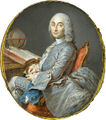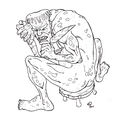Template:Selected anniversaries/September 4: Difference between revisions
No edit summary |
No edit summary |
||
| Line 64: | Line 64: | ||
||1985 – The discovery of Buckminsterfullerene, the first fullerene molecule of carbon. | ||1985 – The discovery of Buckminsterfullerene, the first fullerene molecule of carbon. | ||
||Ernst Carl Gerlach Stueckelberg (February 1, 1905 – September 4, 1984) was a Swiss mathematician and physicist, regarded as one of the most eminent physicists of the 20th century. Despite making key advances in theoretical physics, including the exchange particle model of fundamental forces, causal S-matrix theory, and the renormalization group, his idiosyncratic style and publication in minor journals led to his work being unrecognized until the mid-1990s. | ||Ernst Carl Gerlach Stueckelberg (February 1, 1905 – September 4, 1984) was a Swiss mathematician and physicist, regarded as one of the most eminent physicists of the 20th century. Despite making key advances in theoretical physics, including the exchange particle model of fundamental forces, causal S-matrix theory, and the renormalization group, his idiosyncratic style and publication in minor journals led to his work being unrecognized until the mid-1990s. Pic. | ||
||1996 – Joan Clarke, English cryptanalyst and numismatist (b. 1917) | ||1996 – Joan Clarke, English cryptanalyst and numismatist (b. 1917) | ||
Revision as of 17:42, 26 January 2018
1784: Astronomer and cartographer César-François Cassini de Thury dies. In 1744, he began the construction of a great topographical map of France, one of the landmarks in the history of cartography. Completed by his son Jean-Dominique, Cassini IV and published by the Académie des Sciences from 1744 to 1793, its 180 plates are known as the Cassini map.
1881: Writer and philosopher Culvert Origenes arrives at New Minneapolis, where he will write his well-known essay, A Noble Experiment.
1882: Thomas Edison flips the switch to the first commercial electrical power plant in history, lighting one square mile of lower Manhattan. This is considered by many as the day that began the electrical age.
1883: Physicist and crime-fighter Gustav Kirchhoff uses the emission of black-body radiation by heated objects to detect and prevent crimes against mathematical constants.
1888: George Eastman registers the trademark Kodak and receives a patent for his camera that uses roll film.
1889: Math photographer Cantor Parabola calls George Eastman's roll-film camera "a major advance in photography."
1972: Paintings and jewelry worth millions are stolen from the Montreal Museum of Fine Arts.
2017: Signed first edition of Galileo Galilei, Crime Fighter sells for ten million dollars.







